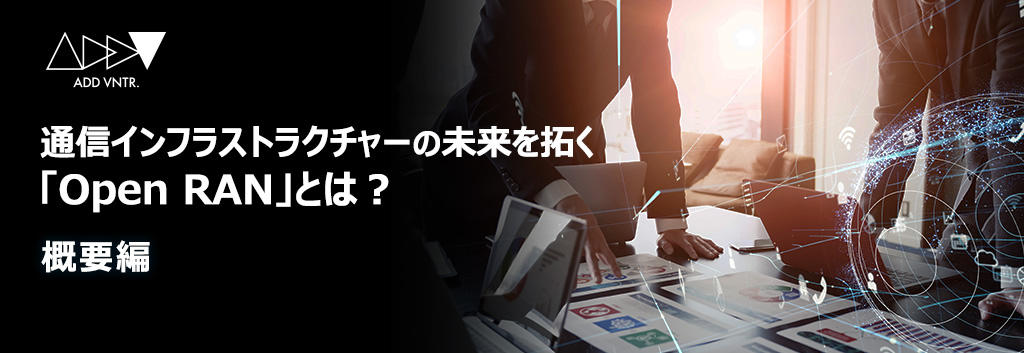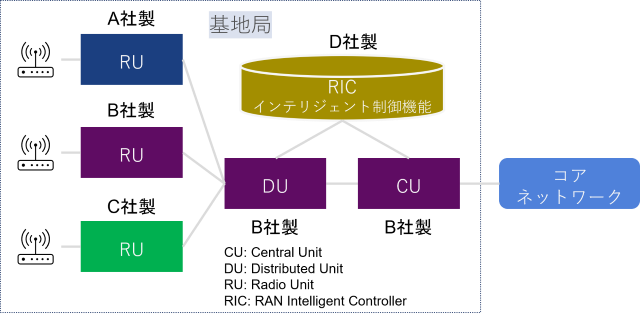
In 2023, approximately three years have passed since 5G (fifth generation mobile communication system) began to be rolled out in Japan. Along with 5G, there is a technology that is attracting a lot of attention as it will revolutionize the communications industry.
That is `` Open RAN,'' which makes the specifications of radio access networks (RAN) open. In the telecommunications industry, which is expected to continue to grow rapidly, there is no doubt that knowledge regarding this technology will be one of the key indicators for mobile carriers and communication equipment vendors to achieve further growth.
Therefore, this time, Macnica DX Consulting Division Security Consulting Department Consulting Division We will deliver an explanation of Open RAN by Katsuya Hino and Seishi Tsukada, who belong to .
This article is divided into two parts: the [Overview] covers the basics of Open RAN, and the [Security] focuses on points to be aware of in terms of Open RAN security. Masu.
What is Open RAN?
--First, please tell us about the basics of Open RAN.
Tsukada: To put it simply, the openness that occurred in the world of IT has also come to the world of telecommunications. For example, in the case of computers, there was a time when specific companies provided systems in bulk. However, since then, it has become more open in various forms, which led to workstations and then to personal computers, and now it's almost like anyone can create something.
Hino: It's certainly easier to understand if you associate it with a computer. Some companies provide everything in one package, such as the OS, apps, and mouse, but in the same way, specific vendors are responsible for the operation and management of wireless base stations that are operated and managed by mobile carriers (mobile network operators). ) has traditionally been the basic flow of purchasing in bulk. However, just as computers became open and the variety of operating systems increased, the advent of Open RAN has made it possible for multiple vendors to configure a single wireless base station.

Open PC (image).
--Why is Open RAN attracting so much attention?
Tsukada: A major factor is avoiding vendor lock-in. Previously, even if mobile carriers wanted to upgrade the functionality of their wireless base stations, they had to go through the vendor responsible for operation and management. Even if a mobile carrier requested something, there were cases in which it was not possible to get what they wanted because it was influenced by the vendor's development plan. On the other hand, as wireless base stations become open, mobile carriers will be able to introduce parts and new functions from a variety of sources. That means you have more options.
In the case of problematic vendors, the mobile carrier that purchased the wireless base station will initially be provided with courteous support, but I have heard that the quality of support sometimes deteriorates after that. As openness progresses, these problems should become less likely to occur.
Hino: Another aspect is that the transition from 4G to 5G has made it easier to open up technology.
Tsukada: As seen with the computers I mentioned earlier, the natural trend is for technology to become more open. In the past, a specific vendor consistently constructed a system to guarantee the operation of wireless base stations. However, with the advent of 5G, technology has advanced and the performance of equipment has improved, and we have gained the power to cover the overhead that is an issue with openness, to the point where wireless base stations can be configured by multiple vendors. I arrived there.
Advantages and disadvantages of popularization
--What are the benefits of the widespread use of Open RAN?
Hino: This is related to the avoidance of vendor lock-in mentioned earlier, but if competition increases through multi-vendoring, costs can be lower than an all-in-one from a specific vendor, and the quality of upgrades and support can be expected to improve.
Tsukada: Even if you end up using one vendor, having the option to request other vendors will give you negotiating power. In addition, multi-vendoring basically allows the vendor to be more flexible than if they were to contract all-in-one. This will make it easier for specialized vendors to emerge, which will accelerate competition.
--What do you think about the disadvantages?
Tsukada: The first thing that comes to mind is the issue of integration. Since Open RAN basically involves assembling equipment from different vendors to assemble a wireless base station, the challenge is who will ensure that the system as a whole operates correctly.
Hino: This is also easier to understand if you think about it using a computer. Even if you buy the graphics board, main unit, OS, etc. separately and assemble it, it may not work properly depending on the case. Also, you have to think about security. If the parts that make up a wireless base station are owned by multiple vendors, it becomes more difficult for users to check whether each vendor is taking proper security measures and who to contact for inquiries. Even when users contact the vendor, they may be told that ``we don't manage that part'' and get turned around.
By the way, even if we look at the market broadly, Open RAN wireless base stations still lack a proven track record.

Mechanism of multi-vendor base stations.
Existence of industry organizations
--Please tell us about the O-RAN Alliance (Open Radio Access Network Alliance), an industry organization that promotes the spread of Open RAN.
Tsukada: Basically, it is an organization led by mobile carriers. Historically, countries in Europe are close to each other, so there is a greater need to connect communication systems between different mobile carriers than in Japan. For this reason, a movement has been underway in Europe for more than 40 years for mobile carriers to define their own standard specifications and, based on these specifications, to enable interconnection between devices introduced from various vendors. .
Among them, the 3 generation, that is 3G Activities for standardization have continued since then. 3GPP(3 rd Generation Partnership Project) There is a group called. 4G/5G The standard specifications of 3GPP However, there are still cases where the scope of standardization is limited or where there is disagreement over whether or not to standardize in the first place. result, 3GPP Several consortiums have been launched to supplement areas that cannot be covered by one alone. they merged O-RAN Alliance have become.
Hino: By the way, there are some countries where mobile communications businesses are members of the O-RAN Alliance, but their vendors are not.
Tsukada: The countries listed as board members include Japan, China, India, the United States, Singapore, Germany, France, Spain, Italy, and the United Kingdom. We maintain a balance between Asia, America, and Europe.
Open RAN situation in Japan
--What is the current situation regarding the spread of Open RAN in Japan?
Tsukada: From a global perspective, it can be said that Japan is one of the more popular countries. The three main pillars of openness are interfaces, virtualization, and operation automation using AI. One area that has taken the lead in this area is the opening of interfaces.
Wireless base stations can be roughly divided into two types: RU (Radio Unit), which is closest to the antenna, and CU/DU (Central Unit/Distributed Unit), which is installed in the central data center.In Japan, these are divided into It started from there. All mobile phone carriers in Japan are implementing this point.
Hino: NTT Docomo and Rakuten Mobile were among the first to incorporate Open RAN technology into their networks, and are actively promoting their efforts by selling their know-how overseas. However, we have not yet reached the point where all of our wireless base stations are open at once, including other companies.
The three elements I mentioned earlier are being advanced step by step, and Japan is the country that has used the first of these technologies and has a proven track record. Also, these three elements are scheduled to be updated rapidly through the O-RAN Alliance, so from a technological perspective it is still in the process of evolution, and from a business perspective, it can be called a blue ocean.
Hurdles to popularization
--What challenges are there in promoting the spread of Open RAN?
Hino: I think the key point when going multi-vendor is, ``Who will have total responsibility for this, including integration?'' With conventional wireless base stations, the vendor basically guaranteed responsibility by saying that the OS and applications all work, but when converting to Open RAN, the responsibility lies with the mobile communications company that manages and operates the base station. I'll move on to business.
Tsukada: At the moment, there are two main patterns. The first is a pattern in which mobile communications businesses with high technological capabilities take responsibility on their own, such as the five major European companies and NTT Docomo. The second pattern is for mobile carriers to form a group and ``let's create some recommended patterns within that group.'' Rather than complete liberalization, it is more like choosing good parts and using proven combinations.
However, even if it is proven, there will always be differences between the laboratory and the company's network, so an integrator is required. For small and medium-sized businesses, I think a realistic solution would be to check the combinations in advance and introduce them.

Integration (image).
--As you mentioned earlier, there seem to be various security issues.
Tsukada: That's right. The security functions required for each device have been determined, but when it comes to ensuring a certain level of security, the question of "who should do it?" arises. There is also the belief that ``we are safe because others are doing it properly,'' and even if Company A says, ``We have these security features in place, we would like you to do that as well.'' Company B may object, saying, "No, I don't think we need that, so we won't allow it." In order to prevent such things from happening, someone must take total responsibility.
Hino: The Open RAN Alliance says, ``By increasing transparency, security becomes safer than before.'' It is true that with all-in-one products from specific vendors, it has been difficult to confirm whether they are truly safe. However, the idea is that by making it open, it will be easier for individual issues to be exposed.
Tsukada: Up until now, we had no choice but to believe what the vendor said: ``The interface is private, so no intrusion is possible, and security is guaranteed, so it's safe.'' However, even if the interface is not exposed, the device's connection point still exists, allowing an attacker to gain entry through the connection point. Device passwords can be leaked onto the Internet, and the protocols used are limited, so from an attacker's perspective, it's easy to find. Given this reality, it can be said that defining security in openness is important.
--thank you. From now on, I would like to hear more about Open RAN security.
